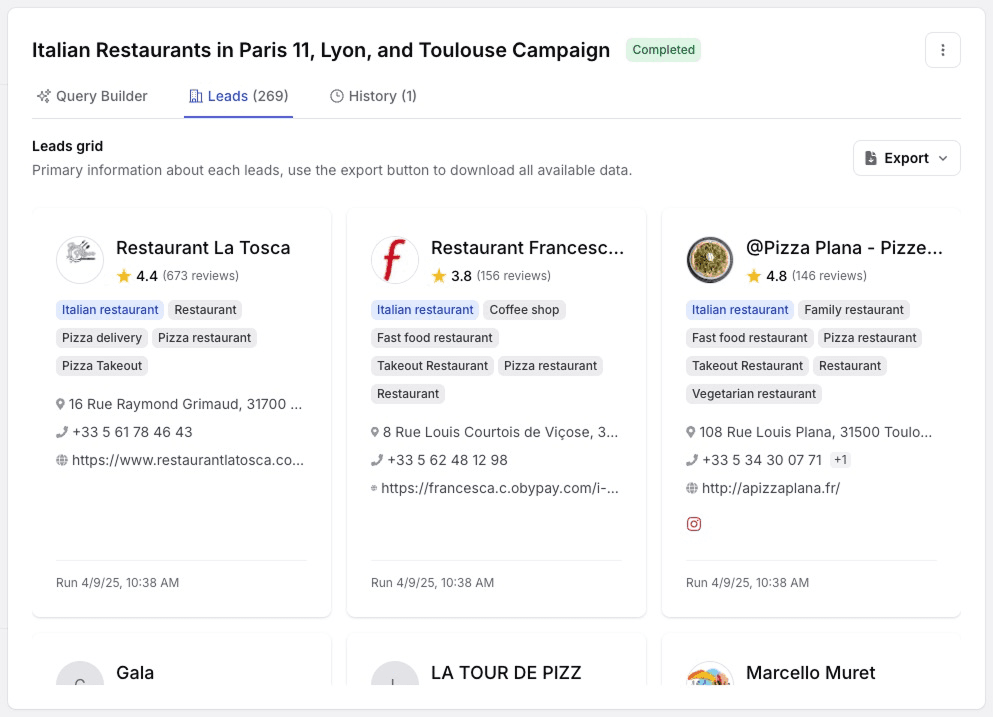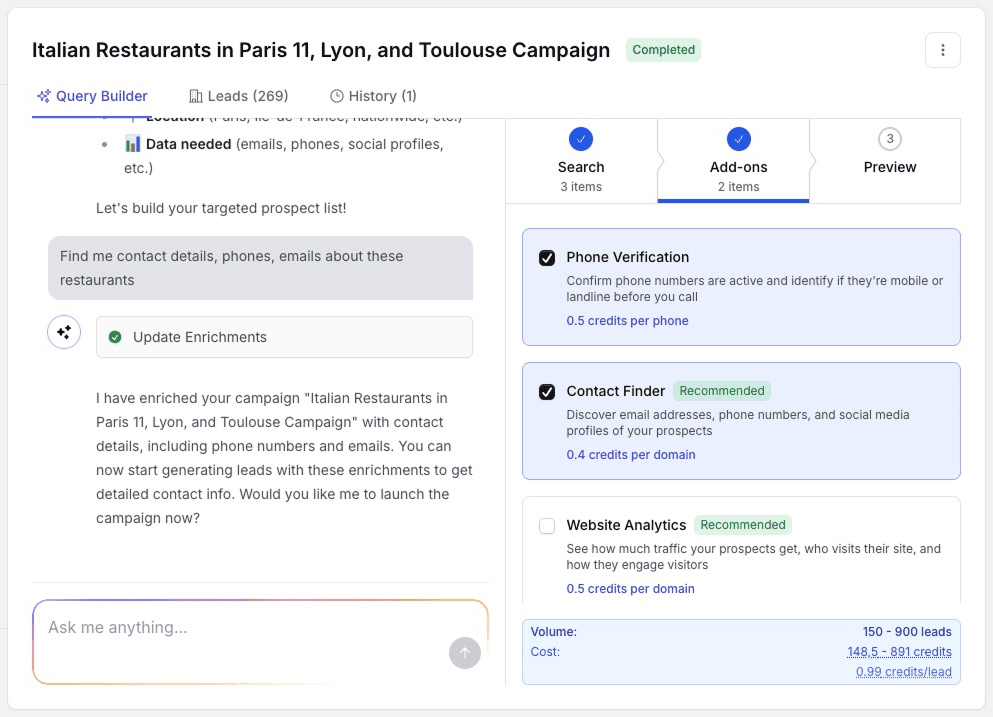7 Effective Local Lead Generation Strategies That Will Transform Your Business in 2025
Discover the most effective local lead generation strategies for 2025. Learn how to leverage AI tools, Google Maps data, and targeted enrichment to capture high-quality local business opportunities.
Posted by
Related reading
Comparing Business Enrichment Tools: The Ultimate Guide for 2025
Discover how modern business enrichment tools stack up against each other. Learn about key features, pricing models, data quality, and find out which solution offers the best ROI for your specific needs.
How to Generate High-Quality Local Leads for Your Agency
Discover effective strategies and tools to generate qualified local leads for your agency. Learn how to automate lead generation, enrich prospect data, and convert more clients without extensive manual research.
How to Build a Google Maps Business Directory Without Coding Skills
Learn how to create a comprehensive Google Maps business directory without any development skills using AI-powered tools like AskMyBiz that automate data extraction and enrichment.
7 Effective Local Lead Generation Strategies That Will Transform Your Business in 2025
As we move further into 2025, the landscape of local lead generation continues to evolve at a rapid pace. Businesses that adapt to these changes are seeing unprecedented growth in their local customer acquisition efforts, while those relying on outdated methods are struggling to maintain competitive edge. In this comprehensive guide, I'll share seven proven strategies that are delivering exceptional results for businesses targeting local markets this year.
Why Local Lead Generation Matters More Than Ever
Before diving into specific strategies, it's important to understand why local lead generation has become such a critical focus for businesses across industries:
- Higher conversion rates: Local leads typically convert at 2-3x the rate of generic leads due to proximity and relevance.
- Reduced competition: Properly targeted local campaigns often face less competition than broader marketing initiatives.
- Enhanced customer lifetime value: Research shows that local customers tend to have higher retention rates and lifetime value.
- Greater cost efficiency: Targeted local campaigns typically deliver more favorable ROI than wider-reaching efforts.
With these benefits in mind, let's explore the most effective approaches for capturing and converting local leads in today's market.
Strategy 1: AI-Powered Local Business Data Extraction
The emergence of specialized AI tools has revolutionized how businesses identify and connect with local prospects. These platforms can automatically extract and enrich business data from multiple sources, creating comprehensive prospect profiles with minimal manual effort.
Here's how leading organizations are implementing this approach:
- Defining precise local targeting parameters: Rather than broad geographic filters, successful campaigns are using hyper-local targeting such as specific neighborhoods, business districts, or even radius-based selection around strategic locations.
- Leveraging AI-based enrichment: Tools like AskMyBiz can automatically enhance basic business listings with decision-maker contact details, verified phone numbers, email addresses, and social profiles.
- Implementing quality scoring: Advanced users are applying automated lead scoring to prioritize prospects based on multiple factors including business maturity, online presence, and engagement signals.
Case studies show that companies implementing AI-powered extraction are identifying 30-40% more qualified local leads while reducing research time by up to 80%.

Strategy 2: Google Maps Intelligence Optimization
Google Maps has evolved from a simple navigation tool to one of the most valuable sources of local business intelligence. Forward-thinking organizations are developing sophisticated approaches to leverage this resource:
- Strategic query formulation: Rather than basic location searches, effective campaigns use carefully constructed queries that combine geographic parameters with business attributes to discover highly relevant prospects.
- Comprehensive data capture: Beyond basic contact information, leading organizations are capturing rich contextual data including business categories, ratings, review content, and operating hours.
- Competitive intelligence gathering: Advanced users analyze competitor distribution, ratings, and customer engagement patterns to identify market gaps and opportunities.
- Automated monitoring: Setting up systematic monitoring of Google Maps data to identify new businesses, ownership changes, and other significant updates in target areas.
When properly implemented, these Google Maps intelligence techniques can yield consistent flows of high-quality local leads with significantly higher engagement rates than generic prospecting methods.
Strategy 3: Vertical-Specific Outreach Customization
Generic outreach is yielding diminishing returns in 2025. The highest-performing local lead generation campaigns are now built around industry-specific approaches:
- Industry-specific value propositions: Rather than one-size-fits-all messaging, successful campaigns develop distinct value propositions for different business categories.
- Vertical benchmarking: Providing prospects with relevant performance benchmarks compared to similar local businesses in their category.
- Customized content pathways: Creating industry-specific content journeys that address the unique challenges and opportunities in each vertical.
Organizations implementing vertical-specific approaches report 40-60% higher response rates and significantly improved conversion metrics compared to generic outreach efforts.
Strategy 4: Location-Based Digital Presence Analysis
In 2025, a business's digital footprint reveals critical insights about their needs and readiness to engage. Leading organizations are developing sophisticated analysis frameworks:
- Website maturity assessment: Evaluating local businesses based on website sophistication, mobile optimization, content quality, and technical performance.
- Local SEO gap analysis: Identifying opportunities by evaluating Google Business Profile optimization, local keyword visibility, and citation consistency.
- Social engagement measurement: Analyzing social media presence and engagement metrics to identify businesses with active digital marketing initiatives.
- Technology stack identification: Detecting the marketing and operational technologies businesses are currently using to identify integration opportunities.
This analytical approach enables hyper-personalized outreach that addresses specific gaps in a prospect's digital presence, dramatically increasing relevance and response rates.

Strategy 5: Multi-Channel Lead Nurturing Orchestration
The most successful local lead generation programs in 2025 recognize that converting prospects requires coordinated multi-channel engagement:
- Synchronized channel sequencing: Developing carefully timed sequences across email, phone, social, and even direct mail touchpoints.
- Behavior-based path optimization: Adapting outreach channels and messaging based on prospect engagement patterns.
- Local credibility signals: Incorporating location-specific testimonials, case studies, and references to build trust with local prospects.
- Channel preference detection: Identifying and prioritizing each prospect's preferred communication channels through response analysis.
Organizations implementing orchestrated multi-channel approaches are seeing 50-70% improvements in lead-to-opportunity conversion rates compared to single-channel strategies.
Strategy 6: Location-Specific Lead Scoring and Prioritization
Sophisticated lead scoring has become essential for effective local lead management in 2025. Leading organizations are developing nuanced scoring models:
- Geometric proximity weighting: Assigning variable scores based on distance from strategic locations like offices, service areas, or existing customer clusters.
- Business maturity indicators: Evaluating signals like years in business, employee count, and physical location characteristics.
- Digital engagement scoring: Tracking and scoring engagement across website visits, email interactions, social media touches, and other digital touchpoints.
- Opportunity sizing estimation: Incorporating revenue potential and lifetime value projections into prioritization models.
Well-implemented scoring systems enable sales teams to focus on the highest-potential local opportunities, significantly improving conversion efficiency and ROI.
Strategy 7: Automated Local Lead Enrichment and Qualification
The final piece of the local lead generation puzzle in 2025 is automated enrichment and qualification:
- Comprehensive contact discovery: Using specialized tools to identify decision-makers and their direct contact information at local businesses.
- Verification services: Implementing phone and email verification to ensure data accuracy before outreach begins.
- Intent signal detection: Monitoring for indicators of purchase intent such as website behavior, content consumption, and social media activity.
- Automated pre-qualification: Developing systems that evaluate leads against key qualification criteria before human engagement.
Organizations using automated enrichment report 30-40% improvements in contact accuracy and significant reductions in wasted outreach efforts.
Implementation Case Study: Regional Service Provider
To illustrate the impact of these strategies, consider this real-world example of a regional HVAC service provider that transformed their local lead generation:
The company had previously relied on general advertising and purchased lead lists with disappointing results. After implementing the strategies outlined above, they achieved remarkable improvements:
- Lead volume: Identified 450+ highly relevant local business prospects in their service area within two weeks.
- Contact accuracy: Achieved 85% accuracy on decision-maker contact information through AI-powered enrichment.
- Response rates: Vertical-specific outreach generated 28% response rates compared to previous 5-7% with generic messaging.
- Conversion efficiency: Multi-channel nurturing and lead scoring improved lead-to-customer conversion from 10% to 23%.
- Cost per acquisition: Overall cost per acquired customer decreased by 62% while increasing average contract value.
Conclusion: Building Your Local Lead Generation Engine
The local lead generation landscape of 2025 offers unprecedented opportunities for businesses that embrace these advanced strategies. By combining AI-powered data extraction, Google Maps intelligence, vertical-specific approaches, and sophisticated enrichment, organizations can build consistent pipelines of high-quality local opportunities.
The key to success lies not in implementing these strategies in isolation, but in developing an integrated system where each approach reinforces and enhances the others. Organizations that build comprehensive local lead generation engines are positioning themselves for sustainable growth in increasingly competitive markets.
As you consider your approach to local lead generation, focus on building systematic processes rather than one-off campaigns. The businesses seeing the greatest success are those that treat local lead generation as an ongoing core capability rather than a periodic initiative.